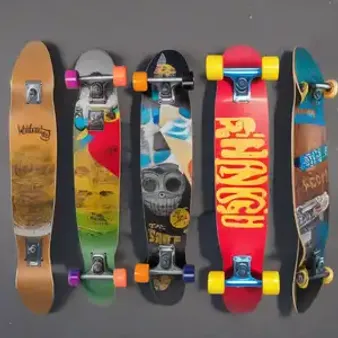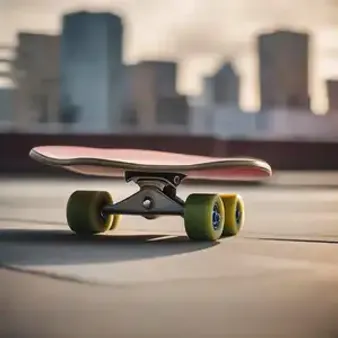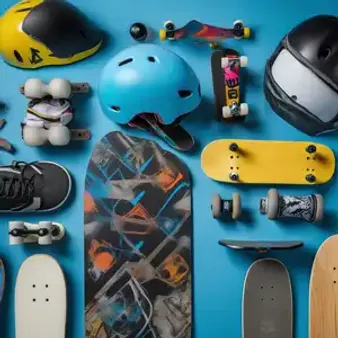Table of Contents
Ready to roll? kizworld is here to guide you through the exciting world of real skateboards. Whether you're a beginner taking your first steps or a seasoned skater looking to upgrade your ride, understanding the ins and outs of real skateboards is key to unlocking your full potential. Let's dive in!
Topic | Key Takeaway |
|---|---|
Real Skateboard Construction | Real skateboards are made of high-quality materials like maple wood decks, durable trucks, and polyurethane wheels designed for performance and durability. |
Choosing a Real Skateboard | Consider your riding style, skill level, and personal preferences when selecting the right real skateboard size, shape, and components. |
Mastering the Basics | Start with the fundamentals: finding your balance, pushing off, turning, and stopping safely. Practice makes perfect! |
Essential Gear | Protect yourself with a helmet, elbow pads, and knee pads, especially when starting. |
Understanding Real Skateboards: Construction and Materials
Okay, so you're curious about real skateboards! They're more than just a plank with wheels. Think of them like well-tuned machines, built for awesome tricks and smooth rides. Let's break it down:
First up, the deck – that's the wooden platform you stand on. Most real skateboards use hard maple wood, layered together for strength and flexibility. It's like a springboard and a shock absorber all in one! Ever heard of a "pop"? That's the satisfying "snap" the deck makes when you ollie (jump) – the more layers, the more pop!
- 7-ply (layers): Great for beginners, a bit more forgiving.
- 8-ply: The sweet spot for many, good pop and durability.
- 9-ply and up: Super strong, for those hardcore landings!
Next, we've got the trucks – those metal axles that connect the wheels to the deck. They let you steer and turn. Trucks have bushings inside that act like little cushions, determining how "loose" or "tight" your turning feels. Want to learn how to do a grind on a rail? You'll be thankful for those trucks! For more on skateboard tricks, check out our article on how to do a 180.
Now for the wheels – made of polyurethane, a kind of tough plastic. They come in different sizes and hardnesses. Smaller, harder wheels are fast and slide easily (think street skating). Larger, softer wheels are grippier and better for rough surfaces (perfect for cruising or hitting ramps). Just like choosing the right shoes for a sport, you pick wheels based on what you want to do!
Wheel Size | Good For |
|---|---|
50-53mm | Street, tech tricks |
54-59mm | All-around, parks |
60mm and up | Cruising, longboards |
Understanding Real Skateboards: Construction and Materials
Choosing the Right Real Skateboard for Your Needs
So, you're ready to pick out your very own real skateboard! It's like choosing a best friend who's always down for an adventure. But with so many options, where do you even begin? Don't sweat it, we'll find the perfect board for you.
Deck Size Matters
First things first, let's talk about deck size. Imagine trying to ride a tiny scooter – not easy, right? The same goes for skateboards. Deck width is measured in inches, and it's all about finding what feels comfy for your feet and riding style. For beginners or younger skaters, a narrower deck (around 7.5"- 8") is easier to maneuver. For you guys with bigger feet or those who want more stability, a wider deck (8.25" or higher) might be the way to go. It's all about finding your balance – literally!
Deck Width | Good For |
|---|---|
7.5" - 8" | Beginners, younger skaters, street skating |
8.25" - 8.5" | All-around, street and park skating |
8.5" and up | Larger skaters, ramps, pools |
What's Your Skateboarding Style?
Next up, think about what you want to do with your real skateboard. Are you all about hitting the skatepark, mastering cool tricks like a kickflip? Or do you see yourself cruising down the sidewalk, feeling the wind in your hair? Maybe you're into the smooth flow of surf skating? Your riding style will heavily influence your board choice. If you're unsure, a good all-around board is a great starting point. It's like having a Swiss Army knife – it can handle a bit of everything!
- Street skating
- Park skating
- Vert skating
- Cruising
- Surf skating
Choosing the Right Real Skateboard for Your Needs
Mastering the Basics: Riding Your Real Skateboard
Alright, you've got your real skateboard, you're stoked, and you're ready to shred! But hold on, little dude, even Tony Hawk started with the basics. Think of it like learning to ride a bike – a little wobbly at first, but once you get it, you'll be cruising in no time!
Finding Your Footing
First things first: figure out which foot feels most natural forward – that's your "stance." Most people are "regular" (left foot forward) or "goofy" (right foot forward). No judgment here, it's all about what feels right! Now, find a smooth, flat surface, like a driveway or empty parking lot (make sure there are no cars around!). Hop on your board! Don't worry, you don't have to start rolling just yet. Just get used to the feel of the board beneath your feet, find your balance point. It's like making friends with your board before you start doing tricks! Speaking of skateboarding tricks, you can learn how to do a heelflip by reading our article on how to do a heelflip.
Stance | Description |
|---|---|
Regular | Left foot forward, pushing with the right |
Goofy | Right foot forward, pushing with the left |
Time to Get Rolling!
Ready to feel the wind in your hair? (Or at least a light breeze?) With your front foot planted, gently push off with your back foot. Start slow, get a feel for the momentum. To steer, lean slightly in the direction you want to go. It's all about balance, just like riding a bike! To stop, you can either drag your pushing foot on the ground or, once you're feeling braver, learn to pivot your foot and use the tail of your board to brake. Don't be afraid to bail (jump off) if you're going too fast or feel unsteady! It's all part of the learning process. For tips on choosing the perfect skateboard for your skills, check out our guide on how to choose the right skateboard.
- Practice pushing off gently.
- Lean into turns.
- Start with dragging your foot to stop.
- Don't be afraid to bail!
Mastering the Basics: Riding Your Real Skateboard
Essential Gear for Real Skateboarders
Alright, so you've got the board sorted – awesome! But before you hit the streets or the park, let's talk about safety gear. I know, I know, it might not seem as cool as a gnarly kickflip, but trust me, protecting your noggin and your bones is way cooler than a trip to the ER. 😉
Protect Your Melon: Helmets Are Key
First and foremost, a helmet is non-negotiable. Think of it like a seatbelt for your head! It's your best friend against nasty falls and unexpected slams. And hey, helmets come in all sorts of cool designs these days, so you can still look stylish while staying safe. Match it to your board, your shoes, or even your mood! Remember, real skateboarders protect their most important asset – their brainpower! For tips on choosing the right skateboard, you can check out our guide on how to choose the right skateboard.
Type of Helmet | Features |
|---|---|
Standard Skate Helmet | Durable, affordable, good all-around protection |
Full-Cut Helmet | More coverage for the ears and back of the head |
Pad Up for Peace of Mind
Next up, pads! Elbow pads and knee pads are like your trusty sidekicks, ready to take the brunt of the impact when you're learning new tricks or pushing your limits. Think of them as your body armor against scrapes, bruises, and those "road rash" souvenirs you definitely don't want. I remember when I was first starting out, I took a tumble and landed right on my knees. Let's just say, I learned my lesson about knee pads the hard way! Don't be like me – suit up! For more on skateboarding tricks, you can check out our article on how to do a 180.
- Elbow Pads: Protect those funny bones!
- Knee Pads: Save your knees for skating, not hobbling!
- Wrist Guards: Good for beginners, especially when learning to fall.
Essential Gear for Real Skateboarders
Final Thought
Real skateboarding is more than just a hobby; it's a community, a passion, and a way of life. With the right real skateboard and a dose of determination, you'll be carving up the streets and landing tricks in no time. So grab your board, embrace the learning curve, and experience the thrill of real skateboarding!